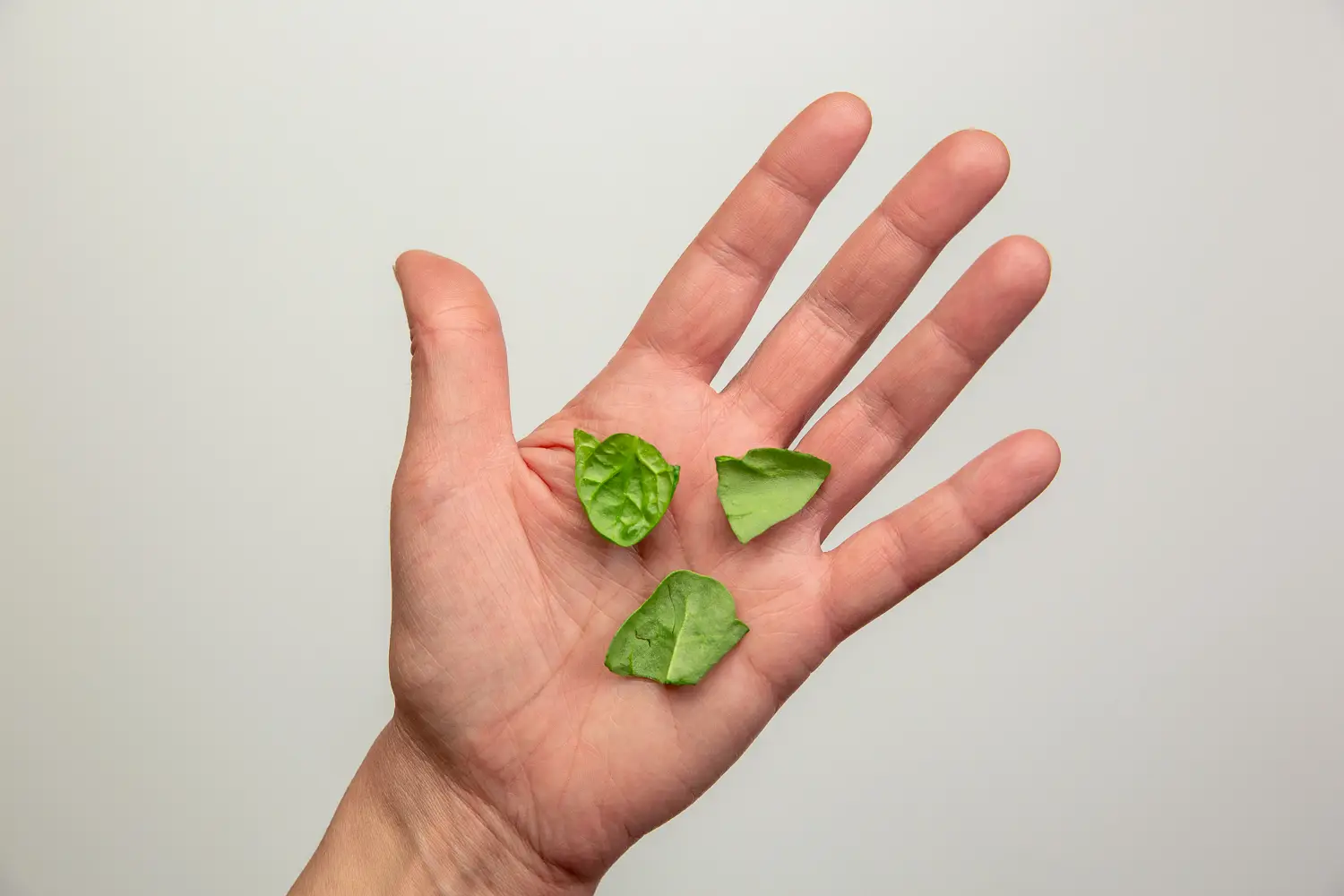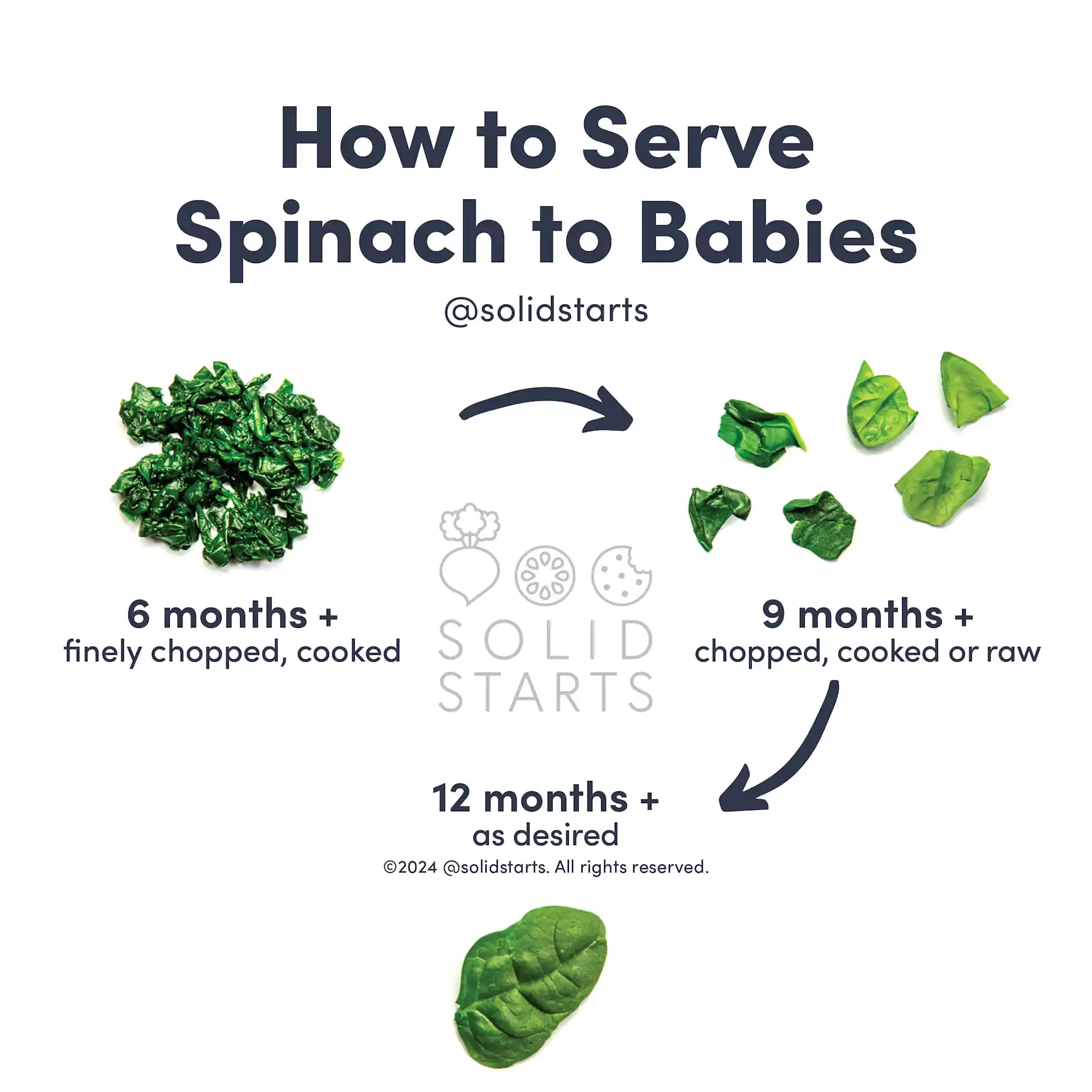Access our First Foods® Database in the Solid Starts App.
Learn moreSpinach
Vegetable
Age Suggestion
6 months
Iron-Rich
Yes
Common Allergen
No

When can babies have spinach?
Spinach may be introduced as soon as baby is ready to start solids, which is generally around 6 months of age.
Spinach originated in West Asia and today there are many varieties related to two main types: savoy spinach with crinkly, curly leaves and flat-leaf spinach with smooth leaves that can be round, oval, or heart-shaped. There are also different species of edible leafy greens that are commonly called “spinach” in English and prepared in a similar way, including pui in India, komatsuna in Japan, kangkong in the Philippines, sambu or sissoo in Brazil, amaranth varieties like efo tete in Nigeria and morogo in South Africa, and many more.
How do you serve spinach to babies?
Every baby develops on their own timeline, and the suggestions on how to cut or prepare particular foods are generalizations for a broad audience.
6 months old +:
Mix finely chopped cooked spinach into mashed vegetables, porridge, or another soft food for baby to scoop. You can also mix it into finger food like egg strips or meat patties. Spinach stems are edible and do not pose any unusual choking risk, though many babies will spit them out until they learn to grind with molars. While you can offer very well cooked spinach pieces on their own, they may cling to the tongue and inside the mouth. Mixing the pieces into soft scoopable foods or mixing them into finger foods can minimize coughing and gagging.
9 months old +:
Serve chopped pieces or thin ribbons of cooked or raw spinach mixed into soft foods for baby to scoop, cooked dishes, or sauces. Alternatively, continue to stir finely chopped and cooked spinach into age-appropriate foods. If serving bite-sized pieces or ribbons of spinach, know that the pieces of spinach leaf can stick inside baby’s mouth and cause some harmless gagging. Spinach stems are edible and do not pose any unusual risk, though many babies will spit them out until they learn to grind with molars.
12 months old +:
Offer spinach as desired, cooked or raw, on its own, or mixed into other dishes. Continue to expect some spitting, but you may start to see more swallowing and consumption around this age, especially as the molars come in, which help the child grind more challenging textures. This is also a great age to encourage self-feeding with utensils. If the child needs help, simply pre-load an age-appropriate fork with a piece of spinach and lay it next to the food for the child to pick up.


For a quick reference to the key nutrients babies need, check out our Nutrient Cheat Sheet for Babies.
Videos
Is spinach a choking hazard for babies?
No. Spinach presents a low risk when safely prepared for a child’s age and developmental ability, though, in theory, an individual could choke on any food. To reduce the risk, prepare and serve spinach in an age-appropriate way as described in the How to Serve section. Note also that flecks of raw or cooked spinach can stick to baby’s tongue or the roof of the mouth, causing some harmless gagging. As always, make sure you create a safe eating environment and stay within an arm’s reach of baby during meals.
Learn the signs of choking and gagging and more about choking first aid in our free guides, Infant Rescue and Toddler Rescue.
Is spinach a common allergen?
No. Allergies to spinach are rare, but they have been reported. Individuals who are allergic to latex may be allergic to spinach or experience Oral Allergy Syndrome (also known as pollen-food allergy). Oral Allergy Syndrome typically results in short-lived itching, tingling, or burning in the mouth and is unlikely to result in a dangerous reaction. As spinach is naturally high in histamine, some individuals who are sensitive to histamine may experience symptoms that are indistinguishable from an allergic reaction after the ingestion of large quantities of spinach.
As you would do when introducing any new food, start by offering a small amount during the first few servings. If there is no adverse reaction, gradually increase the amount served over future meals.
Recommended Guide: Introducing Allergens
Is spinach healthy for babies?
Yes – although it is not as rich in iron as marketers once claimed. While it is true that fresh spinach contains some iron, the amount of iron is not as high as it was once thought to be and the presence of oxalates in the leafy green can decrease the body’s ability to absorb these minerals. Cooking spinach and eating the leafy green alongside foods with vitamin C helps the body absorb more of the iron.
Spinach has incredible concentrations of vitamin K and beneficial plant compounds called polyphenols. Together, these nutrients promote healthy bones, blood, and cell function. The leafy green also contains a good amount of B vitamins to fuel a baby’s growth and plant-based antioxidants called carotenoids that support a baby’s developing vision.
★Tip: Wash fresh spinach before cooking or serving. Spinach and other leafy greens can be a higher risk food for E. coli infection, and washing helps reduce the risk of illness.
Do I need to worry about nitrates in spinach?
No. Offer vegetables that contain nitrates (arugula, beets, carrots, lettuce, spinach, and squash to name a few) as part of a variety of foods in the diet. Nitrates are naturally-occurring compounds which, if consumed in excess, may negatively affect oxygen levels in the blood. That said, babies who are allowed to self-feed typically do not consume excessive amounts of solid food because they need lots of practice to learn how to eat it. Nitrates in vegetables are generally not a cause for concern, and the benefits of introducing vegetables with nitrates as part of a balanced diet typically outweigh the unlikely risk of excessive consumption.
★ Tip: To reduce the risk of illness from nitrates, if making homemade spinach puree, make sure to serve it immediately and do not share leftovers that have been stored in the refrigerator for more than a day or two with baby, as nitrate content can increase with improper storage.
Our Team
Written by
Expert Tips Delivered to Your Inbox
Sign up for weekly tips, recipes and more!
Copyright © 2025 • Solid Starts Inc







